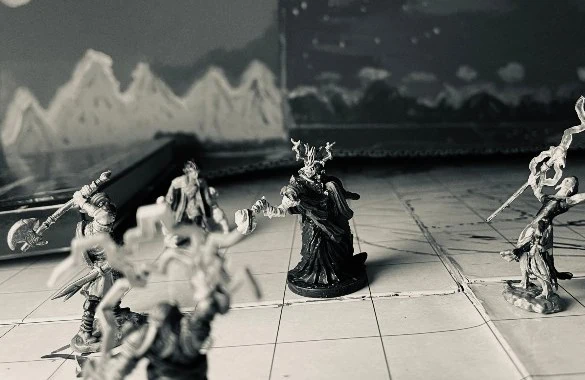Ray of Sickness 5e is a simple spell attack from a distance that has a chance of making a monster sick for one round.
At first look, the damage and effects of this 1st-level spell seem good. However, there are a few things that make it less impressive.
We’ll talk about why most spellcasters don’t use the sick spell and what DMs and players can do to change the taste and balance of the spell.
Ray of Sickness is the spell that every kid wishes they had when they were young. It can help you act sick long enough to get out of school, and you wouldn’t even have to make your own fake puke (does anyone do that?).
Now you can use it in your Dungeons and Dragons game to help your characters avoid going to school.
Ray of Sickness is one of the best first-level necromancy spells, even though it doesn’t do much. Most first-level spells are limited in what they can do.
But, like everything else in Dungeons and Dragons, all it takes is a little imagination to turn it into something completely different.
The Basics
Ray of Sickness is a Necromancy spell of the 1st level. It can be cast with just one motion and has a range of sixty feet. Ray of Sickness only needs two things to work: Verbal and Somatic.
How it Works

When you cast this spell, you send a ray of sickeningly green energy at your target. You must cast a spell at that subject from a distance.
If you hit, the person you’re trying to poison will take 2d8 poison damage and have to make a Constitution saving throw. If the target doesn’t make a successful save, it will stay poisoned until the end of your next turn.
When you cast this spell in a spell slot of level 2 or higher, the damage goes up by 1d8 for every slot level above the first. 2d8 poison damage is a lot for a first-level spell, and it means you can start doing real damage right away.
What does the Poison Effect Do?
The target of this first-level spell has a chance of becoming poisoned, which is an extra bonus.
When a creature is poisoned, it has a disadvantage on all Attack rolls and Ability Checks until the poisoning wears off or is removed.
Your Spell Save DC is used to figure out the DC, or Difficulty Challenge, that your subject has to beat. This affects Ray of Sickness until your next turn.
What is the School of Necromancy?
One kind of magic is called the School of Necromancy. Spells in this School look at the forces of life, death, and the living dead.
Many of the later spells in this School of Magic are banned and have a lot of negative and evil connotations.
Since Ray of Sickness is a magic that makes the target sick for a short time and costs them health, it is easy to put it in the category of Necromancy.
If you are very good-aligned and refuse to use necromancy spells, I wouldn’t worry too much about this one ruining your image.
With magic like “Finger of Death” on the table, you’ll be fine. Aside from that, if you don’t want to use spells from the School of Necromancy, you should start thinking about how you’re going to bring party members back to life, since every resurrection magic belongs to the School of Necromancy.
Maximizing The Spell

Although this is a first-level spell, it retains its utility outside of the first level. Not only does the damage increase if you cast Ray of Sickness at a higher spell level, but it becomes harder to beat the Constitution Saving Throw as your Spell Save DC goes up.
If you want to make this spell extra useful, along with many of your other ranged attack spells, consider taking the Feat Spell Sniper.
This doubles the range of any spell requiring a ranged attack roll and ignores all partial cover. Paired with Spell Sniper, your Ray of Sickness can have a 120-foot range.
Better in the Early Game or in the Late Game
Although this spell seems really good for a first-level spell, there comes a time when you need to ask if it’s worth it to keep using it.
Indeed, when you’ve got higher-level spells that undoubtedly have more impact or inflict more damage, it seems unwise to keep expending your spell slots.
So, let’s break it down and look at some higher-level alternatives.
The Player
In the early game, Ray of Sickness is better. It does a good amount of damage, but as you move through your missions, you’ll find stronger spells or spells that last longer.
If your goal is to make your target roll worse, Blindness/Deafness may be more successful and harder to beat. But Blindness/Deafness isn’t as good as Ray of Sickness because it doesn’t do harm.
But Ray of Sickness might be enough to get you by until you can get a fifth-level spell spot. You should now be able to use the spell “Contagion.”
Contagion is even more dangerous than Ray of Sickness, but you have to hit your target with a melee spell and be able to touch them for it to work.
They still have to make a Constitution save, though. If they fail three Constitution saving throws, the sickness you gave them takes hold, and they can’t make any more Constitution saving throws against the spell until it’s over in seven days.
The Dungeon Master

In the late game, it’s worth it to use Ray of Sickness. In Players, your goal is to beat the enemy as quickly as possible. Ray of Sickness, on the other hand, can be a short-term problem for your players.
Depending on the type of campaign you’re running and the boss your players are facing, Ray of Sickness is one of the best spells. This is especially true if the boss isn’t a real threat but more of a bother that keeps coming back.
It does poison damage for a short time, and the damage it does can be a small threat. At the first level, you can roll 16 damage, but it’s unlikely that will happen.
You probably don’t want a real Big Bad to use Ray of Sickness as a first-level spell. Instead, you might want to encourage them to use Ray of Enfeeblement or Contagion.
These are higher-level spells that are more dangerous than Ray of Sickness but have the same effect, though in a more complicated way.
Who Can Use It
Sorcerers, Wizards, and Clerics in the Death Domain are the only ones who can use this power. But you could get around the class barrier if you took a feat like “Magic Initiate.” Since this ability is of the first level, it should be available right away.
Ray of Sickness is also a good spell to learn right away, especially if you’re a Sorcerer or Wizard who doesn’t have access to all of the spells.
Ray of Sickness can do up to 16 points of damage right away and protect you and your allies from being hit by poisoned effects.
As a Cleric, this extra benefit is even better because it can help you save your spell spots so you don’t have to use them over and over again to heal. This means you can do more damage.
Getting Creative

Attack spells don’t leave much room for creativity, yes. You can describe the spell in a more interesting way or change how it looks so it fits your character better, but other than that, there isn’t much else you can do with it… or so you think.
Have you ever wanted to fake being sick in a way that people would believe? When I was a kid, I remember acting sick and then getting caught because it didn’t look real enough.
Well, Ray of Sickness can give you that, and it will look very real. You can choose to do the least amount of damage possible when you hit. In this case, that would be two.
You can also choose to fail your Saving Throws on purpose to let a certain impact happen. In the case of Ray of Sickness, that can give you a temporary poisoning affect or “sickness.” This could help you not only get out of some scenarios, but also get into others.
Let’s say your characters are trying to break into the sick ward of a hospital, but none of you have a good enough ruse check.
Well, all you need is someone who wants to take part and a spellcaster who doesn’t mind throwing away a few first-level spell points.
With a hand on their back, they can cast Ray of Sickness when needed (hopefully quietly!) and get your willing victim into the sick room.
The affect will wear off after six seconds, which is why you have to cast it over and over again. Hopefully, only one will be good enough to convince them.
Your ready participant just needs to keep up the act long enough so that people don’t notice right away.
IS RAY OF SICKNESS 5E A GOOD SPELL?
No, Ray of Sickness isn’t as good as other first-level spells that Wizards and Sorcerers can learn. Even though a 1st-level long spell that does an average of 9 damage isn’t great, it’s not terrible either. Poison damage, on the other hand, is the worst in the game.
With his very useful spreadsheet, Reddit user RocksInMyDryer found that poison immunity is the most common immunity in DnD 5e, with about a quarter of animals having it. Both the effect and the damage are the same, so Ray of Sick is pretty much useless against 25% of the monsters you’ll face.
On top of that, three-quarters of animals that can be targeted have Constitution as their highest average stat, which is a fact I owe to another awesome Reddit user, Fontanapink, and their awesome spreadsheet.
Also, the poison from Ray of Sickness only works if you win two rolls in a row, which makes it even less safe as a condition that you can use often.
Overall, Sorcerers and Wizards have a lot of first-level powers that are stronger, more reliable, and more useful than Ray of Sickness.









